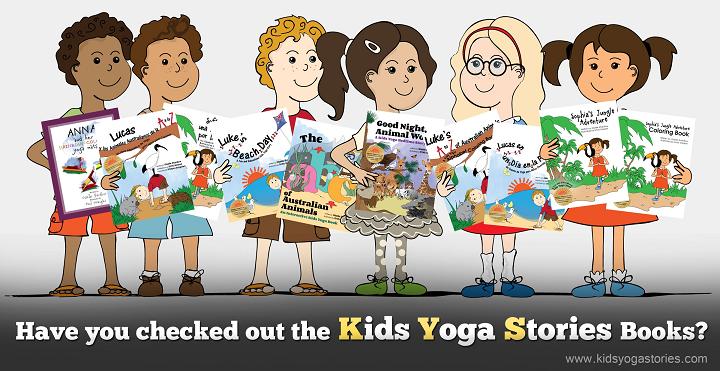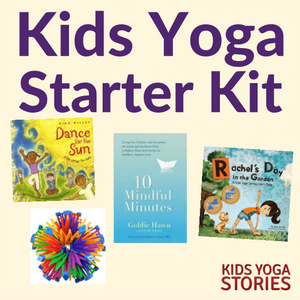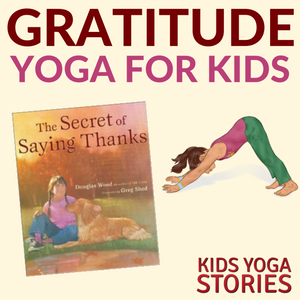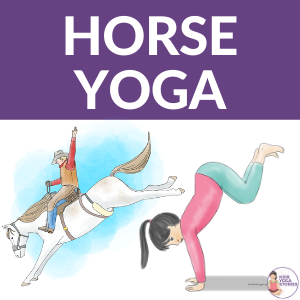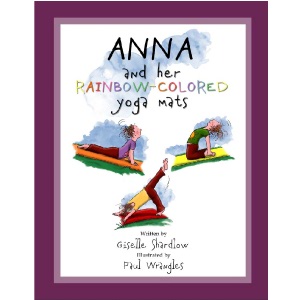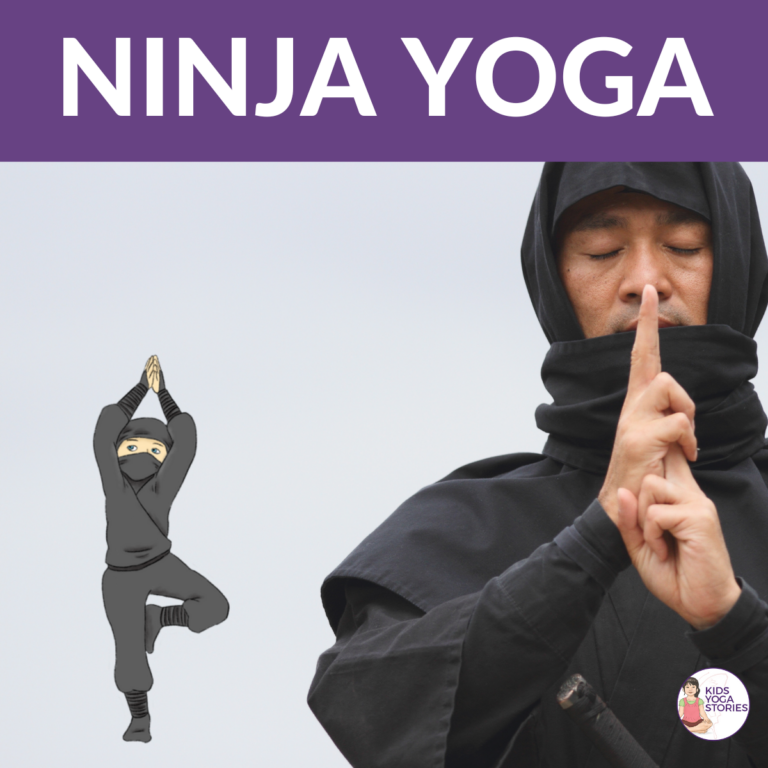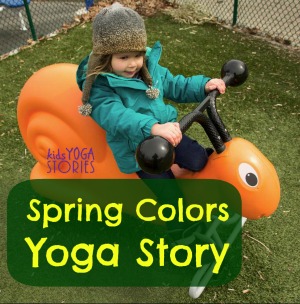Why Yoga Books for Kids are a Great Idea
My passion is integrating yoga for kids with story. I believe in the power of having engaging experiences by pairing reading with action. Reading can be good for our minds and bodies. This post details the benefits of yoga books for kids.
What is a yoga book?
A yoga book integrates yoga postures and philosophy into a storybook for children.
The purpose of our yoga stories is to integrate reading, movement, and fun to foster critically thinking children who are creative, responsible, and globally minded. Children follow the Yoga Kids in the books and act out various pretend journeys while learning about different places in the world as well as foreign cultures and new animals.
What are the benefits of yoga books for kids?
- They offer real and meaningful content.
- They encourage cooperation and teamwork.
- Children are focused and attentive on the active storytelling.
- Children learn about a variety of topics.
- Yoga builds strength and flexibility.
- Yoga promotes a healthy lifestyle and boosts energy.
- They encourage self-expression and build self-confidence.
- Pairing stories and movement utilizes left- and right-brain thinking.
- Yoga eases tension, helps manage stress, and calms the mind.
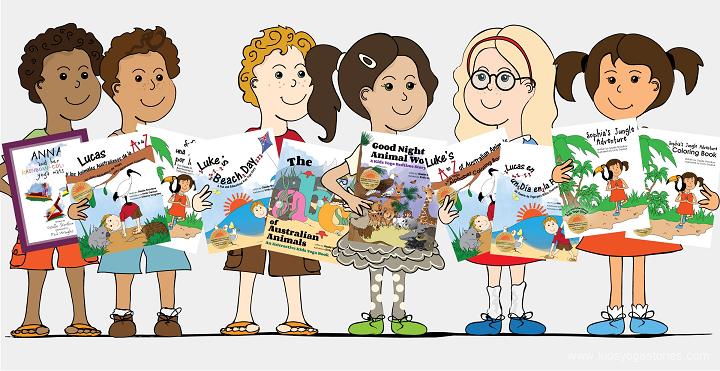 Our Yoga Kids holding a collection of our yoga stories for kids
Our Yoga Kids holding a collection of our yoga stories for kids
Why read and act out our yoga books for kids?
In April, 2014, I asked our Kids Yoga Stories community about the benefits of yoga stories and if yoga books increase physical activity. Below, you’ll find twenty reasons why I think yoga books for kids are great, plus testimonials from our customers and readers to back up those beliefs:
1. The connection is real and meaningful.
Children learn effectively when information is presented in a real and meaningful way that enables them to apply it to their lives. Our yoga stories take children on imaginary journeys, through movement and story, to real places like the jungle, ocean, forest, and beach.
What Katy (Preschool teacher) says:
“Yoga is a tool we use at school every day. We are a non-profit arts-infused pre-K and afterschool program for K-8 kids. Recently, we were learning about the Olympics and used yoga poses that resembled the events in the Winter Olympics. Instead of sitting on the carpet and looking at a book, the students moved, stretched and held positions like athletes. Not only did they learn kinetically but also strengthened their bodies. Yippee for yoga! Thanks for sharing all your great ideas and wisdom.”
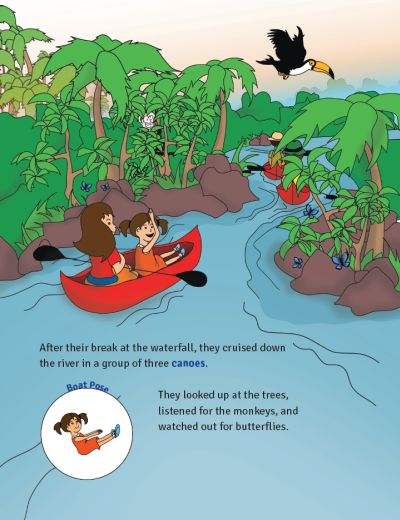 Page from Sophia’s Jungle Adventure.
Page from Sophia’s Jungle Adventure.
2. The poses are presented in a sequential and logical format.
The sequences of the yoga poses take young “travelers” on a journey that is sequential and logical. The yoga stories have a flow.
What Carolyn (Kids yoga teacher) says:
“As I read the yoga story to the students in my class, they follow along with the yoga pose pictures and move their bodies accordingly. We reinforce the yoga poses and comprehension after the story is over by repeating the physical poses and verbally retelling what is remembered from the story.”
3. The creative storytelling is engaging.
Our yoga stories act as a guide, but readers are free to add their own creative voice and inner storyteller. Your child’s creativity and imagination is highly encouraged.
What Vicki (Kids yoga teacher) says:
“The children really engage with combining stories from books with yoga. Often spin-off things happen when the children have made connections, either extending or embellishing the story—often, they become more animated.”
What Kathy (Kids yoga teacher) says:
“I use Yoga Stories in my after-school yoga program and in my children’s yoga class at my yoga studio. I am also a 200RYT yoga instructor. I love how many ideas I get from the stories and how they get the kids excited about creating their own yoga flows. I have a few of your yoga books, and the kids love them. Thank you! I love Anna and her Rainbow-Colored Yoga Mats. Teaches about diversity in so many ways. Kids ‘get it.’”
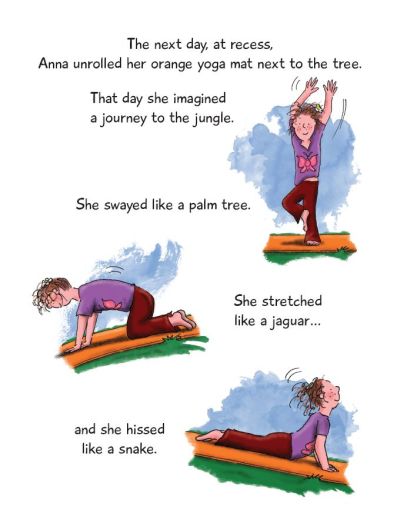 Page from Anna and her Rainbow-Colored Yoga Mats
Page from Anna and her Rainbow-Colored Yoga Mats
4. The stories are flexible to suit different needs.
We respect that every situation is different. You bring different experiences to the reading of the yoga books, and so do your children. Altering, adapting, and changing the yoga stories to suit your needs is welcomed.
What Jodi (PE teacher) says:
“I incorporate yoga each to my daily Physical Education classes. Yoga stories give me themes and ideas for my lessons. Adding reading to my lessons meets Common Core Standards. I own Anna and her Rainbow-Colored Yoga Mats and have used that in class. Your extension ideas work out so well for my instruction. My students in Kindergarten through Second Grade get a daily ‘motor break.’ (In addition to daily P.E.!) I often use your themes in this 15-minute motor break. They are the perfect length. Students come in (all 36 of them!), go to their assigned mats, I ring the bells three times, and our daily theme begins. I love your resources and value your information.”
5. Yoga stories encourage cooperation.
Our yoga stories are designed to encourage cooperative, sharing, and accepting behavior. The focus is on the journey, not whether your students can hold a perfect posture. A shared journey with other yoginis is practice in gaining invaluable teamwork skills, providing an opportunity to share and care for each other. The interactive nature of our yoga books encourages group reading and yoga play.
What Ilka (Early childhood teacher) says:
“I personally noticed on each kid their better flexibility. In the beginning, they were not able to reach their toes. Their attention span increased, and their behavior in class improved. Their coordination and socialization skills have improved, too. Parents have come to me telling me how their kids are sharing and showing all the poses at home, trying to be yoga instructors for their parents, which is a fantastic and joyful time between children and parents. During each of my classes imagination is present, I have my planning and the children create stories to go along with our poses. Sometimes, we recreate and have fun inventing new stories.”
What Jeanette (Kids yoga teacher) says:
“Kids like seeing other kids doing yoga (peer influence) and can relate to the stories. Visuals help kids learn. Stories also help to bring issues up and help with encouraging acceptance, decrease bullying, decrease stress and discussions on such things. The movements in using yoga stories make the stories come to life. That makes even the reading more fun!”
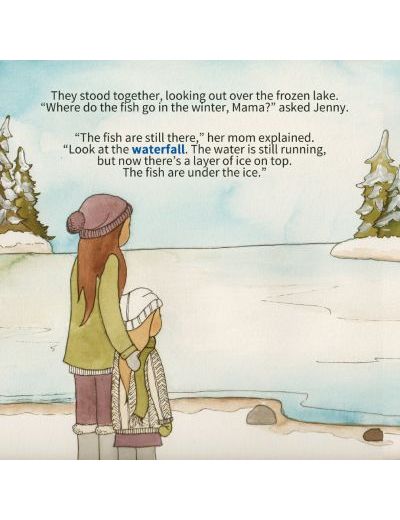 Image from Jenny’s Winter Walk
Image from Jenny’s Winter Walk
6. Yoga links movement to breath.
Children are encouraged to notice their breath during the practice of the yoga poses. The basic principles of yoga emerge naturally.
What Andi (School counselor) says:
“I have used the newsletter yoga stretches as a morning or start of lessons activities. The kids LOVE and expect the stretches and calm down. It helps when they transition into my room from the hallway and classrooms. I know this statement is not scientific, but…I truly see a different shine in their eyes after the stretches. They may have had a rough start to the day, and then after the yoga cards, the kids shine with a different focus. We are ready to attend my lesson. I have even added three belly-breathings before you walk into your classroom, which in turn, has helped the classroom teachers with transitions.”
7. Focus and attention improves after yoga.
Our yoga books aim to help children take “brain breaks” from their busy lifestyles, so that they can focus on their learning endeavors.
What Marty (Classroom teacher) says:
“The stories fit in perfectly with the ELA setting. I have used them as ‘brain breaks’ for my students. We are a departmentalized 3rd grade (meaning that students rotate between three classes: ELA, Math or Science/Social Studies, and our class blocks are an hour and 45 minutes. I have practiced yoga for a number of years and have realized many mind/body benefits from my practice. I have seen it help many of my students to refocus and continue working. For me, it’s not so much increasing physical activity as it is to help students take that ‘brain break’ and refocus.”
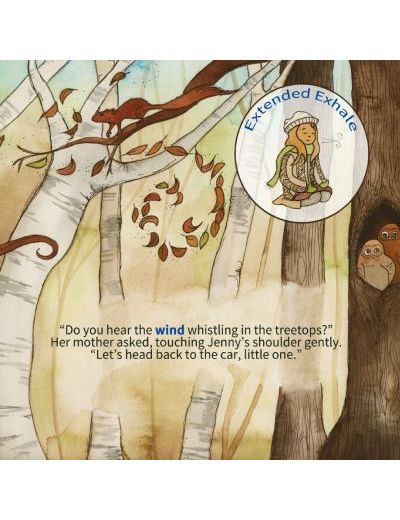 Page from Jenny’s Winter Walk
Page from Jenny’s Winter Walk
8. Children learn about different topics.
The intention of our yoga books for kids is for young “travelers” to learn about different places, people, and animals around the world through movement, yoga poses, and self-expression.
What Debbie (Preschool yoga teacher) says:
“The yoga stories have been linking creative thinking with physical movement and encourage the children to move their bodies in ways they are not used to. Storytelling is a great way to introduce and teach yoga to children, without ever calling it yoga! The yoga stories also teach on the subject, and I find myself learning new things, too. I use the yoga stories in addition to teaching dance which is a great complementary movement to balance my program. I love the yoga stories! I love the different themes, and I pair them up when planning my movement/dance activities. It’s great!”
What Stacy (Kids yoga teacher) says:
“Kids yoga helps children learn about how their bodies move, help them relax, help them be mindful of others, helps them appreciate and respect their environment and others around them, helps them with breathing techniques to calm their minds and bodies. Kids Yoga Stories get the kids so excited about trying to copy the poses that the kids in the corner of each page are demonstrating. They want to get up and move their bodies into the same position as the pictures in the books. Such a great resource for kids yoga teachers!”
9. Being kind and compassionate.
The foundation of our yoga stories series is built on promoting kindness and compassion. We encourage that these behaviors and conversations are modeled and positively reinforced by our readers.
What Deborah (Kids yoga teacher) says:
“I take a children’s class within an after school club. I love using your yoga stories, I have them all, and I also use many of the ideas that you post on your website. The children are always excited to see where we are going in our yoga adventure using your books and get really engaged with the activity, we stretch, we dance, we get creative, we use music and props such as hula hoops and balls. We learn about the world, the environment, the animals, how to connect with each other and support one another, how to be compassionate, accepting, and kind. We learn how to express ourselves and how to have fun, using your stories as a foundation. We love your yoga books and hope you produce many more. The kids are getting to be physically active, which is so much healthier for them. They can work out any stresses they have acquired physically and emotionally during the day. Using your stories stimulates their creativity whist also instilling calmness. Their favorite book is Anna and her Rainbow-Colored Yoga Mats. Apart from loving the story and the postures, the children really opened up through linked discussion around the storyline about things that worry them, how they have experienced bullying, how they didn’t feel confident, how they didn’t have imagination. This led on to some breathing techniques as well, and as they were leaving, some of the children voiced a promise to be always kind and helpful to other children. We live in quite a harsh area, so this was very welcome. They also like Good Night, Animal World. Two of my students are diagnosed ADHD, and they really surprised me the first time I did this and they become calm and engaged. This book is great for ending class with, but especially for them.”
 Page from Good Night, Animal World
Page from Good Night, Animal World
10. The children build strength and flexibility.
The yoga postures assist children in building strength and flexibility while learning about basic anatomy and physiology.
What Elsa (Kids yoga teacher) says:
“Through my yoga class, the children’s stamina is increasing, enhancing their flexibility (which they already have!), feeling more comfortable expressing themselves through body movement, and having a better physical balance. There are some children who appeared unsure doing any physical activities (during PE), because their lacking in hand and body coordination or pressure to compete. They do feel at ease in the yoga class, exploring the variety of movements and building up their strength through some challenging poses! For inside the classroom, I’m using yoga stretches in the morning circle time, and yoga and dance in the afternoon, where their energy is starting to go up, and there’s a need to release it.”
11. Yoga promotes a healthy lifestyle.
While doing yoga postures does not necessarily help children to lose weight, the practice increases their self-awareness, which ultimately promotes a healthy lifestyle.
What Grace (Dance teacher) says:
“I run the Dance and Fitness programs for three of the Doodle Bugs! centers in the Rochester area. I teach yoga, dance, and fitness to children ages 18 months to 5 years, though the center does provide for children up to age twelve. I provide the yoga stories to the classroom teachers, across all age groups, as supplemental resources to further yoga and movement instruction outside of the classes that I teach. They have been especially helpful tools this year, as it has frequently been too cold for the children to go outside during the day. As you can imagine, it is difficult for the children to get all of their energy out in a safe and constructive manner while being cooped up inside all day. The yoga stories have helped by providing a positive focus for the release of some of that energy.”
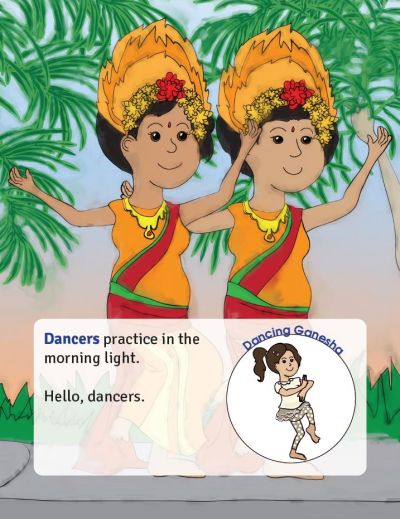 Page from Hello, Bali
Page from Hello, Bali
12. Yoga helps ease tension and manage stress.
Regular relaxation and meditation techniques assist yoginis in combating stressful life situations. Practicing yoga poses helps to increase circulation and ease any blocked tension in their bodies.
What Susan (Kids yoga teacher) says:
“The students engage in yoga exercise, breathing techniques, and meditation. This class emphasizes mindfulness and the brain/body connection to aid self-regulation and develop resilience. This is in part achieved through the physical activity, which not only engages large muscle groups, postural muscles, and develops coordination and balance as well as fine motor skills, it brings awareness of control leading to the greater self-confidence and regulation. The yoga is often presented through storytelling for this particular age group. The yoga poses are weaved throughout the story. This is a fun and creative delivery that captures their interest. I have made lots of stories based on your The ABC’s of Australian Animals. I get lots of ideas and am often inspired by your site. I will be looking for some new yoga stories very soon as I have just about used all my current resources. I have my eye on the Anna and her Rainbow-Colored Yoga Mats storybook from you. Thanks for all you do to support and encourage yoga for kids!”
13. Yoga boosts energy.
Participating in a fun, inspiring, and dynamic yoga sessions boosts the children’s energy levels. This also helps them to develop coping strategies to deal with life’s challenges and develop self-regulation skills.
What Janel (Kids yoga teacher) says:
“The frequency of PE class is limited due to a shrinking budget. Currently, the children share their PE teacher with another school, as well. Offering a free yoga class to children two days a week increases their physical activity and provides them with needed tools to cope with deployments, re-deployments, and the constant unknown experienced by military children. I have used the free yoga stories to incorporate fun with breathing and give the children a tool to cope with their ever-changing and unknown future. Thank you for your help.”
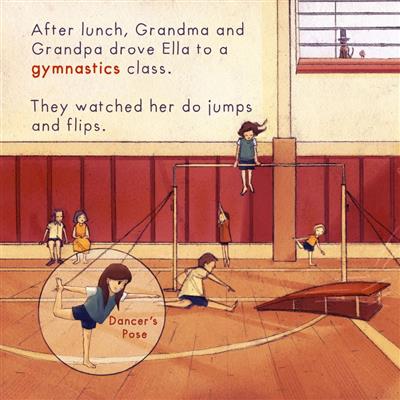 Page from Ella’s Summer Fun
Page from Ella’s Summer Fun
14. Kids yoga stories inspire self-expression.
Our yoga books encourage children to use their self-expression to learn how to control their emotions. Acting out the stories leads to a deeper comprehension of the story, which, in turn, leads to stimulating discussions about the story’s topic.
What Terri (Preschool director) says:
“My husband and I have a family home preschool for children ages 1 1/2 to 5, full-time (7 a.m.-6 p.m. M-F). We haven’t used the books you’ve created yet, but we have used a lot of yoga, and we love your theme-related yoga poses (we’ve recently used the polar animals and St. Patrick’s Day packs and will be using the garden one next month). We’ve found that when we begin our day with yoga, the kids are better-behaved all day long; they gain more motor control earlier and seem to have better control over their emotions, too. The amount of focus and control required to perform the yoga seems to transfer into other areas, too. We are able to use one or two yoga poses quickly when we need a transition activity or when we’re waiting for kids to finish in the bathroom to increase the amount of physical activity we get during the day without needing lots of space or specialized equipment.”
15. Yoga class can provide discipline and consistency.
Children attending a regularly set yoga class benefit from learning discipline, routine, and consistency.
What Cheryl (Classroom teacher) says:
“I do a Thursday yoga recess with kids in the gym of the school I teach in. The kids love yoga stories because they can use their imagination while learning poses. The kids who attend don’t normally enjoy recess, so this gets them moving and learning self-control. I haven’t used your books at this point, but use the yoga stories in the newsletter. The students in my classroom now start each day with yoga breathing and asked if we do the Warrior Poses today, so we had a 20-minute session before we started learning. It really helps kids with attention and focusing issues. Now I’d like to get trained as a certified yoga teacher as we have two classrooms of autistic kids and a lot of ADD kids.”
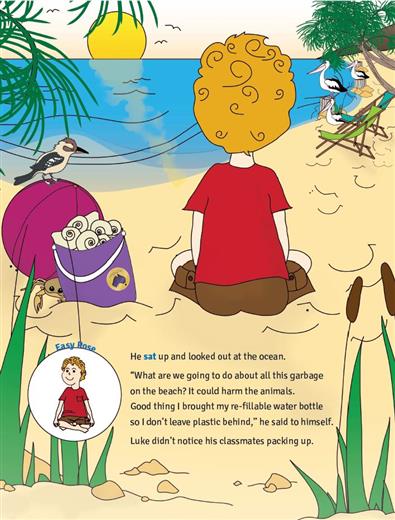 Page from Luke’s Beach Day
Page from Luke’s Beach Day
16. Calm minds follow yoga.
Relaxation in Savasana (Resting Pose) at the end of the journey assists to calm the child’s busy mind. This practice will aid in developing concentration and focus.
What Beth (Literacy coordinator) says:
“I’ve been using yoga and breathing techniques in my classes for three years. I love to use Brown Bear Brown Bear yoga with my special education classes because I am limited in space and there are usually only a few children in those classes. They love it! And I actually use Savasana everyday with every class to calm them before transitioning to the next thing. I always have children ask me when we are doing to do ‘our little rest.’ Yoga has been a powerful tool for me, as well, because I get to focus on my breathing and de-stress at the same time I’m providing an engaging activity for my kids.”
17. Left and right brain thinking gets stronger with yoga.
Our yoga books for kids facilitates the utilization of both the right (creative) and left (logical) brain, providing a well-balanced reading experience.
What Joana (Kids yoga teacher) says:
“Almost every class, I use a story, because kids love stories and is a good way to introduce the postures, to develop their creativity to create different ways to do it, and because they are engaged and happy, they try the best with body and mind. Usually, I read your site, and it gives me ideas to develop on my classes. I always mix stories with games. Sometimes, the story is used on quiet time or meditation time.”
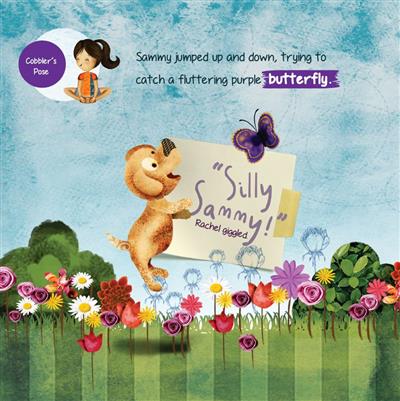 Page from Rachel’s Day in the Garden
Page from Rachel’s Day in the Garden
18. The yoga stories cater to different learning styles.
The reading of our yoga books is intended to be open and adaptable and to cater to different abilities, learning styles, backgrounds, additional needs, and contexts.
What Sharon (Librarian) says:
“Yoga storytime encourages the children to participate by stretching, doing aerobic exercises such as yoga jumping jacks, and yoga poses that increase flexibility, balance, and coordination. Yoga looks different for every child. Each child has a different strength, ability level, balance, and flexibility, so as long as the child is taking the time to focus on the pose they are doing, what they look like is not as important. Yoga, like any other sport or physical activity, takes practice. Yoga storytime increases physical activity for all children because it is inclusive and non-competitive! I have purchased all of your books on Amazon. The kids love them. We practice all the poses first, which makes the list at the end of the yoga book helpful, and then we put them all together for the story.”
What Jamie (Physical therapist) says:
“I am a physical therapist in a developmental preschool. We have acted out some of the stories you have given us as well as made some of our own up in the classroom setting. The Children’s Developmental Services is an inclusive setting with both children who are typically developing and children with developmental delays of various severities in the same classroom. I have used acting out yoga to increase flexibility and movement with the children I work with as a way for the typical developing child to demonstrate movements for the children with delays. This has provided us with good data to see the children experiment with movement in a fun way.”
What Lisa (Kids yoga teacher) says:
“By reading the stories and having the children move along with them, they are engaging their bodies as well as their minds. Using a variety of modalities in reading the yoga stories allows the children the potential to learn in a way that is best for them.”
19. Kids yoga taps into different intelligences.
Howard Gardner offers his study of “Multiple Intelligences” to gain a better understanding of how students learn. Our yoga books taps into all eight intelligences.
Verbal: storytelling, reading, discussing.
Logical/Mathematical: problem solving, sequential, repetition, counting.
Visual: drawing, props, pictures.
Kinesthetic: movement, yoga, manipulating objects.
Musical: rhythms, singing, chanting, music.
Intrapersonal: reflection, calming the mind, questioning, self-awareness, feelings.
Interpersonal: communicating, sharing, cooperating, group work.
Naturalist: appreciation for environment and animals.
What Chrissy (Classroom teacher) says:
“I use yoga in the classroom, and I also created and teach “Story Stretchers” (story time with music, movement, and yoga) for the county library system. I’ve found yoga to be helpful on so many levels. Obviously, it’s great for physical fitness, but what I really like is that it makes children more aware of their bodies and teaches them how to practice self-control. Yoga can be challenging and dynamic, but it can also be relaxing and calm, so it works in many different situations for children with varying levels of skill and activity. It also helps with motor skills. For preschoolers, I particularly like using poses (such as Downward-Facing Dog) that help with developing those small muscles in the hands that are needed for learning how to write and other fine-motor tasks. I also like poses that force children to cross the midline of their body because that helps with reading and writing skills. Add in the story component, and you can pretty much bring yoga (i.e. – physical activity) into just about every learning area from language and literacy to math and science.”
10. Yoga helps children build for the future.
Imagine a high school classroom where students engage in meditation or deep breathing techniques before an exam. Imagine a book corner in a primary school classroom where children are “acting” out a storybook with yoga postures. Our yoga books aim to build a foundation for introducing the benefits of yoga to young children to cultivate globally responsible adults.
What Minda (Kids yoga teacher) says:
“I have used the book Anna and her Rainbow Colored Yoga Mats several times to create delightful children’s yoga classes. The inner-city school where I taught did not have a PE program. The children were from mostly single parent homes and 80% were at or below poverty level. Anna was a fabulous vehicle to teach the kids how to make beautiful new shapes with their bodies while learning compassion and relaxation, as well. I guided each student to pick a pose from the story that intrigued them (the book is loaded with wonderful yoga postures). I then invited them to take the shape of the pose and show it to the class. All of the kids were excited to mimic the poses and add creative twists to each one. By the time our 45 minutes were up together, the kids did about 20 poses. They were exhilarated, enthusiastic, and proud of their yoga accomplishments. They LOVED the story and how it became a vehicle to get them to stretch, balance, focus, strengthen, and quiet their minds and bodies!! I have also used the story for toddlers and pre-schoolers, and the children responded exquisitely to the story as they were either introduced or re-introduced to yoga. They celebrated their ability to move in new ways with their bodies, and their smiles lit up the room.”
 Final spread in Anna and her Rainbow-Colored Yoga Mats
Final spread in Anna and her Rainbow-Colored Yoga Mats
What benefits have you noticed from reading and acting out yoga books for kids?
You Might Also Love
FAQ about Kids Yoga Stories
Monthly Kids Yoga Themes
Holiday Kids Yoga Lesson Plans
List of 58 Yoga Poses for Kids
Kids Yoga Ideas Using Children’s Books
Seasonal Kids Yoga Lesson Plans
Get Updates from Kids Yoga Stories
As you can see, there are many benefits of yoga books! For yoga tips and kids yoga resources, sign up for our weekly Kids Yoga Stories newsletter by adding your email address to the box at the top of the page.

